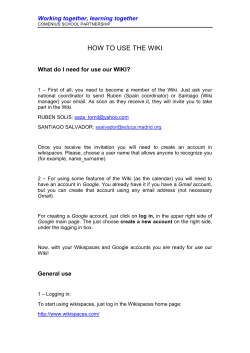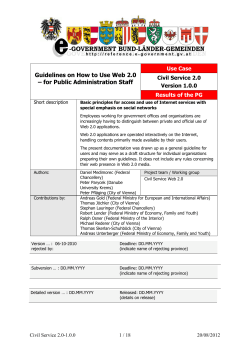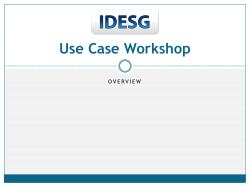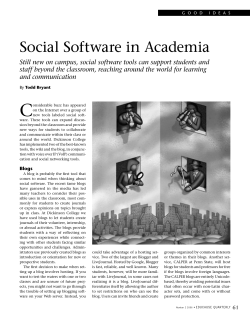
Why You Should Be Using MediaWiki for Design March, 2010
Why You Should Be Using MediaWiki for Design
Documentation and How to Get Started
March, 2010
Heather Arbiter
www.heatherarbiter.com
Contents
Intro............................................................................................................................................................... 3
What is Game Project Wiki: HeatherWiki? ................................................................................................... 3
Why wiki? .................................................................................................................................................. 3
MediaWiki specifically .............................................................................................................................. 3
Why to use wikis ........................................................................................................................................... 4
Additional features from the mods .......................................................................................................... 4
HeatherWiki .......................................................................................................................................... 4
Future features ..................................................................................................................................... 4
How HeatherWiki works ............................................................................................................................... 4
Sections per page ...................................................................................................................................... 4
Automatic generator................................................................................................................................. 5
Section references .................................................................................................................................... 6
Document Info box ................................................................................................................................... 6
Subsection display..................................................................................................................................... 6
Making use of wiki features .......................................................................................................................... 7
Categories ................................................................................................................................................. 7
Templates.................................................................................................................................................. 7
Multiple documents .................................................................................................................................. 7
Variable name templates .......................................................................................................................... 8
Getting Started............................................................................................................................................ 11
How to get started .................................................................................................................................. 11
How do I get my team to use it? ............................................................................................................. 11
How do I know if I should bother? .......................................................................................................... 11
How do I get a document I can give to someone?.................................................................................. 11
Case Study: The Trip .................................................................................................................................... 13
More Wikis .......................................................................................................................................... 13
About........................................................................................................................................................... 14
Intro
Your design document is more than just something to show the publisher. It’s the road of your game
from start to finish. It should be used throughout the design process as a reference for artists, sound
designers, testers, and programmers. It should be the first place people look when they want to know
how something should look or function. It should be easy to find data within it. It should be easy to keep
up to date.
The purpose of a wiki is to be fast and easy. Your GDD should be a living document, maintained
throughout development. So it needs to be kept in a format that allows that.
Using a project wiki to house your documentation is a straightforward way to improve the way design
documentation is used, maintain, and navigated. However, just starting with a plain wiki can lead to
messy confusion with no way to get a document out of it that you can present to a publisher.
To alleviate this, a system of organization and a few tools can be used to make use of the wiki’s features
without sacrificing organization and document cohesion.
What is Game Project Wiki: HeatherWiki?
It is a collection of MediaWiki mods and a system of organization for using MediaWiki to house and
organize design documents.
Why wiki?
The desired easy access and navigation comes from the web format. Online means it’s easy to access.
Interlinking allows phrases to connect directly to explanations and details without disruption. A design
document in other formats has a tree structure but with a web format it’s just that—a web. These
connections make your documentation more usable.
So why not stop at making a website for your document? Well, that comes from the very definition of a
wiki. According to what is probably the best-known wiki, Wikipedia (English), a wiki is:
A wiki is a website that allows the easy creation and editing of any number of interlinked web pages via
a web browser using a simplified markup language or a WYSIWYG text editor.
MediaWiki specifically
There are many wikis to choose from. But MediaWiki has the advantages of being free, open-source,
and very familiar. It is the framework used by Wikipedia and all the other projects in the Wikimedia
Foundation. It is also used by Wikia, a very large wiki farm that includes WoWWiki, GuildWiki and many
other gaming wikis. Additionally, there is a vast array of extensions to add additional functionality to
your wiki.
There are many other wiki frameworks but the one discussed here is MediaWiki.
Why to use wikis
Searchable – find a topic by searching or even find all the pages that talk about something that
you have to change.
Online – accessible by employees away from the office
Easy navigation – clicking links instead of scrolling through pages and pages of text
Automatically tracks changes (who and when) – View the page’s state at any point in time with
only a few clicks. Compare changes and see who is working on what
Templates – Have standardized tables or layouts for frequent use. Weapon stats can be
displayed in a template which only requires the design to fill in fields rather than draw up a
whole table, remember what goes in it, and repeat it for everything that needs that table.
Categories – get access to everything that is in the same category as something else with a
single click. For example, one could find out all the weapons that use some effect without having
to hunt through all the weapons in the GDD to find out.
Optional include - Track more data than you need in a document. You can have more
information on a page that you might not want in the document. You can tag sections of the
page so it’s not included. In depth art info might not be needed in the DDD but you might want
to keep it with the objects it’s for on the wiki.
Talk pages – Allow employees to comment on sections alongside the topic. It’s in the same wiki
so they can link to what they are referring to, changes are tracked, and the whole conversation
is recorded. A programmer might pose a question on some mechanic and the designer’s
explanation is now available on that page for anyone else who might need that information.
Additional features from the mods
HeatherWiki
Simple reorganization – document’s tree structure can be rearranged from an index
Automatic document generation – use the index to build a document that has a traditional
format for submission to publishers and traditional navigation
Instant access to structural information – automatically tracks a sections location in the
document and makes that available.
Automatic categorization – automatically shows a parent section as a category
Automatic display of subsections – view all the child sections of a section on the same page
System for organizing documents
Future features
These features are demonstrated in the latest project but not currently set up to be distributed.
Generate a static version – that isn’t updated when the sections’ contents are updated
Generate additional documents
How HeatherWiki works
One wiki per game
This system is based on have a single wiki devoted to your game. The main reason for this is because
many design documents for different games will have similar sections. For example, a section on player
movement. Having one wiki per game means that one doesn’t have to be concerned with which game
the section is referring to. This makes navigation much simpler. This is also part of what separates this
system from the general studio wiki (see “My studio is using a wiki” below).
Sections per page
Your document is broken down into sections for each topic. Sections of a document each get their own
page. This requires that there are no sections in any documents that have the same name but different
content.
Automatic generator
With each section getting its own page, there must be a way to get an entire document and give it some
structure. This is handled by maintaining an "index" or table of contents that lists all the pages in your
document with the structure of the document. That index is used to generate the entire document. To
change the structure of the document, you don't have to copy and paste sections or run around
changing any section numbers used for reference. Instead, you merely rearrange the index.
The generated document will reflect the structure indicated by the index at the time of generation.
Content in those sections will be "live", however, as it is used with inclusions. So if I change the content
of that section, it will show up in the generated GDD.
Static documents can be generated which will not update at all if you want to keep a record of the
document as a milestone. (This is not available in the current version but is demonstrated on The Trip's
wiki. )
1.Index corresponding to built document
Section references
While the wiki uses internal links to allow easy navigation, printed versions need some other way for a
person to find referenced data. Section numbers based on the hierarchy of the index are maintained for
all pages. That number is displayed on the page itself, in any display of subsections, and in the generated
document. Therefore, only a table of contents needs to be updated when you recreate the document
for printing. These numbers can be added any time via templates. For example: {{seesection|Mechanics|further details on this subject}} yields (see section 3.2 – mechanics
for further details on this subject)
Document Info box
The document info box is automatically displayed on all pages that correspond to sections in the design
document. This tells anyone who looks at the page that it will show up in the document and where in
the document it will appear.
2.Document info box, automatically displayed
Subsection display
Keeping all the sections one per page can become overbearing when there are many small sections. So,
when someone views a super section, all the subsections will also be displayed. This way, if you want to
see mechanics and everything in that section, you only have to go to that page.
3. Document info box, automatically displayed
Making use of wiki features
Categories
Any section that is a subsection of another section belongs in the category of its super section. For your
primary document, this will be done automatically. So Johnny McSample gets his own page which
belongs in Category:Characters. In a normal design document you have easy access to the section
Johnny is in.
However, if you want only characters that wear red hats, you can add the extra [[category:wears red
hat]] to each of those. Then an artist working on the red hat doesn’t need to hunt through all the
characters to figure out which ones the red hat needs to look good on.
Templates
Templates are another reason to use MediaWiki. While, my modifications use some simple templates to
get section numbers of pages and other such text, the beauty of templates is native to MediaWiki.
With templates, you can input all the data about something without having to worry about how it will
be arranged. The arranging of that data is handled by the template. Changes to the template cascade to
all pages that use the template. So if you have a template for weapons, you can standardize a stats chart
for it, rearrange it when you want to add more info, or highlight fields that still need to be filled in.
Additionally, you can quickly find out what pages are using the template.
4. Template page, how it’s used, and result
Multiple documents
Currently, these mods only allow for one document*. However, The Trip's wiki illustrates multiple
documents with one "active document". The active document is the one that is used to tell which
section a page is in, show the document information box, and show the correct automated categories.
In future iterations, the wiki will handle multiple documents more elegantly so structural information
about a page will be shown for any documents it is part of and automated displays (info box, categories,
and sub sections) will be shown no matter what document a page is in.
*Multiple documents can be used, but you have to change the document name and target to say which
one you want to be the active one and then generate from.
Variable name templates1
These are the most complicated bits of wiki technology you will find me recommending. On the one
hand, they add an extra obstacle that can slow down editing and aren't easy to set up at first. On the
other hand, they let you store all the information about an object in one place and then access it to
arrange it in other places.
For example, I have some game object with all its stats, its audio and visual info, full description, etc. I
might want to keep that all in one place. However, I don't want the in-depth art and audio details mixed
in with the object's mechanics in my GDD, nor do I need that in my art bible or audio GDD. Finally, I
might think it handy to get some of those stats in a chart with other objects' stats.
5. Actual object page: shows mechanics and art info along with all the concept art (not depicted)
1
Not a technical term. See also http://meta.wikimedia.org/wiki/Help:Advanced_templates
6. GDD shows this part of the object, mechanics only
7. Art bible shows this part of the object (addition art not depicted)
To do this, instead of keeping the object's info on its normal page and using some standard template, I
keep it on another template using yet another template.
This is what Template:Flame thrower looks like. The red circle shows the small piece of the template
that will allow a passed parameter to change the name of the template when it’s returned. So, I can pass
it “art” as a parameter and it will use Template:Weapon art instead of Template:Weapon.
8. Template use of variable names
So I can use {{Flame thrower}} for gdd version, {{Flame thrower|art}} to get only the art version. On the
page for it, I have both although only allow the former to be included in the design document:
9. Making use of variable templates and optional inclusion
Variable name templates are used in the Indie production guide on the IGDA wiki
(http://wiki.igda.org/Independent_Production_Guide). It is used to display information on various
distribution channels on their respective pages and in comparison tables for quick reference.
An excellent example of variable name templates can be seen with skill boxes and quick references on
GuildWiki (http://guildwars.wikia.com/wiki/Main_Page).
This technique has to be handled manually and does add an extra layer of complication currently,
however, once set up, it’s not hard for a team to get used to using this.
Getting Started
How to get started
Set up a standard MediaWiki install
Get your team on the wiki
Add the HeatherWiki mods2
Set up your index 3
Begin filling in pages
How do I get my team to use it?
1. Use it from the start. Set it up during brainstorming and start making pages right off the bat. Use
it as forums to discuss designs and comment.
2. Get them comfortable with wiki syntax. There isn’t much special syntax so this shouldn’t take
long. One idea to get them working with it is to have them create user pages
3. Treat it as the source of information. When someone asks how something works that is in the
wiki, send them there.
4. If someone has a question that isn't on the wiki, put the answer on the wiki and send them
there. This way its available for everyone else.
How do I know if I should bother?
Size. If you have a large, complex document, a wiki will help it seem smaller and more manageable. If
you have a large team working on your documentation, a wiki makes it easier to collaborate. If your
game is going to take a long time to complete, a wiki is a great jumping off point for new employees and
is much easier to rearrange if your game changes.
How do I get a document I can give to someone?
Use the wiki to view a printable version of the generated design document. The generated design
document contains all sections in the structure indicated by the index. Copy and paste the printed
version into Word. For best results, copy and paste from Chrome. This generally produces a wellformatted design document.
2
3
http://heatherarbiter.com/heatherwiki/index.php?title=HeatherWiki:Setup
http://heatherarbiter.com/heatherwiki/index.php?title=HeatherWiki:Using the index
4.2.5 Store
Weapon peripherals can be stored on a player's back.
If the player has no weapon stored, this will store the weapon they are holding and draw
the hand gun
If they player is holding a weapon and has one stored, this will swap the weapons (store the one
held and draw the one stored).
Stored weapons are visible laying across the characters' back as if hung on a strap.
4.2.6 Draw
Drawing is the act of removing a stored weapon. It can also refer to the act of taking out the hand gun
(which occurs whenever the player has nothing else in their hands).
If the player is holding the hand gun and has a stored weapon, this will put away the hand
gun and draw the stored weapon
If the player is holding a non-weapon peripheral and has a weapon stored, this will drop the
held peripheral to draw the stored weapon.
If the player tries to draw while already holding another weapon, they will swap weapons (held
will be stored and stored will be drawn).
10. Output from copy and paste of document into Word
My studio already has a wiki
Many studios use wikis to house important information. Wikis are a great way to keep a repository of
knowledge on your studio and its practices for especially for indoctrinating new employees.
What makes this different is that it is a system that devotes a single wiki to a single project. This is not a
wiki for the studio; this is a wiki for the game you are working on.
One advantage of having a new, separate wiki, is the potential use post-production. You can export
content from your production wiki and use it to create a fan wiki and start building a place for your
game’s community right away.
If you already have another MediaWiki set up there are a few ways to integrate the idea of one-wikione-game. First, you can set the wikis up as a “wiki family” (see MediaWiki’s manual on wiki families4)
.Second, you can make a separate wiki, but just use single sign on for employees (see “I want to have
multiple wikis, but only require registration once” in the MediaWiki FAQ5). Another idea is to keep
everything on the same wiki but use different namespaces. This means that the content from each game
will need to have the namespace (Namespace:Page name) in front of it which means additional
4
http://www.mediawiki.org/wiki/Manual:Wiki_family
http://www.mediawiki.org/wiki/Manual:FAQ#I_want_to_have_multiple_wikis.2C_but_only_require_registration
_once
5
overhead, but you can now use one wiki (see “How do I add additional namespaces?” in the MediaWiki
FAQ6).
Case Study: The Trip
The Trip is an in-development game being developed by HeatherWiki creator, Heather Arbiter and three
other graduate students at RIT. The Trip uses MediaWiki and the HeatherWiki system to store all of its
documentation including:
High Concept Document (HCD) (Treatment)
o Concept, scope, business case
Game Design Document (GDD)
Art Bible
o Guidelines for artists
Technical Design Document (TDD)
o Tools, architecture, coding standards, etc
Game Production Document (GPD)
o Schedules, meetings, milestones
Individual Research Documents (IRD)
o Additional project requirement for RIT
For this project, functionality was expanded to contain multiple documents and variable name
templates are used for some features. The former is not part of the distributed version of the extensions
(currently) and the latter does require someone more familiar with wikitext and a deeper understanding
of how templates are used.
This project is a great example of a team learning to use the system and not leaning on a single person
who knows wikis to do all the wiki work. It shows how the system can be implemented and how to take
advantage of it to organize the same data in multiple ways and how using the index can save time when
the structure of the document needs to be changed.
The screenshots in this paper come from The Trip’s wiki. The content is owned by The Trip’s developers:
Heather Arbiter, Jay Austin, Kapish Rawat, Josh Wilson.
More Wikis
Capstone (The Trip) - http://heatherarbiter.com/capstone
Sierra - http://heatherarbiter.com/sierrawiki
Tango - http://heatherarbiter.com/tangowiki
Shelf Life (main project wiki)- http://heatherarbiter.com/heatherwiki
Revenge of the Duzzles (first project wiki)- http://heatherarbiter.com/mediawiki
Ownership of the game content for these wikis is indicated on the main page of each wiki.
6
http://www.mediawiki.org/wiki/Manual:FAQ#How_do_I_add_extra_namespaces.3F
About
HeatherWiki was developed by Heather Arbiter after attempting to use MediaWiki to house a design
document without a system or tools available. Building on that experience, experiences with design
documents in general, and experiences with MediaWiki, Heather was about to build a system during
two independent studies on the project.
Heather gained her experience with MediaWiki by working on GuildWiki, the original, unofficial wiki for
the game Guild Wars. There, she served as sysop (standard administrator) and bureaucrat (top-level
administrator) participating in discussions on policy, content and formatting.
© Copyright 2025












